
The soldier flies are a family of flies. The family contains over 2,700 species in over 380 extant genera worldwide. Larvae are found in a wide array of locations, mostly in wetlands, damp places in soil, sod, under bark, in animal excrement, and in decaying organic matter. Adults are found near larval habitats. They are diverse in size and shape, though they commonly are partly or wholly metallic green, or somewhat wasplike mimics, marked with black and yellow or green and sometimes metallic. They are often rather inactive flies which typically rest with their wings placed one above the other over the abdomen.
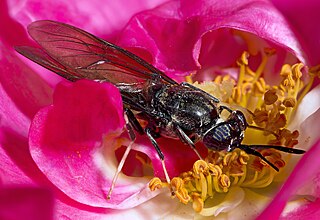
Hermetia illucens, the black soldier fly, is a common and widespread fly of the family Stratiomyidae. Since the late 20th century, H. illucens has increasingly been gaining attention because of its usefulness for recycling organic waste and generating animal feed.
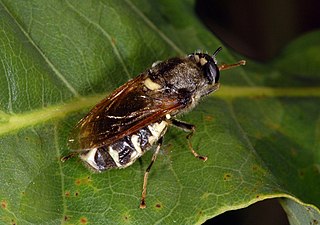
Stratiomys singularia, the flecked general, is a Palearcticspecies of soldier fly.
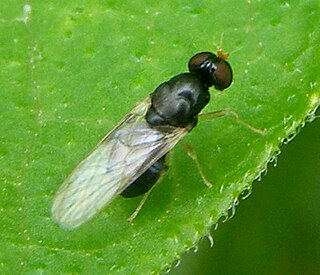
Pachygaster leachii, the yellow-legged black, is a European species of soldier fly.

Pachygaster is a genus of flies in the family Stratiomyidae.

Pachygaster atra, the dark-winged black, is a European species of soldier fly.
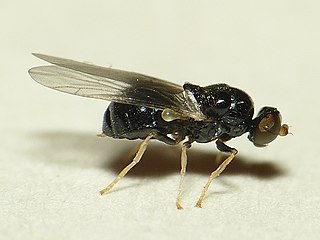
Neopachygaster meromelaena, the silver-strips black, is a European species of soldier fly.

Neopachygaster is a genus of flies in the family Stratiomyidae.
Eupachygaster is a genus of flies in the family Stratiomyidae.

Pachygastrinae is a subfamily of flies in the family Stratiomyidae.
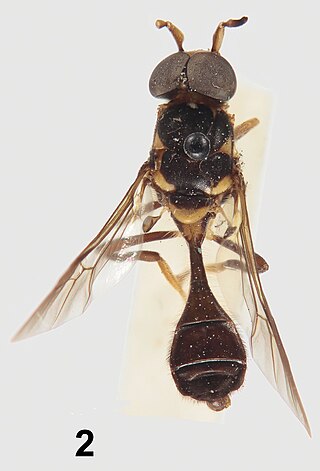
Parastratiosphecomyia stratiosphecomyioides is a species of fly in the family Stratiomyidae. It is native to Thailand. Its genus name comes from Ancient Greek, meaning "Near soldier wasp-fly", with its species name meaning "wasp fly-like". It is considered to be the animal with the longest valid scientific name; the name Gammaracanthuskytodermogammarus loricatobaicalensis was longer, but was suppressed and is no longer valid. The proposed name for the bacterium Myxococcus llanfairpwllgwyngyllgogerychwyrndrobwllllantysiliogogogochensis is longer, but it is not an animal, and under the rules of nomenclature for bacteria, the name still must be published in the International Journal of Systematic and Evolutionary Microbiology (IJSEM) before it is accepted as valid. P. stratiosphecomyioides, sometimes referred to as the Southeast Asian soldier fly, was described in 1923 by British entomologist Enrico Brunetti. This insect is usually between 10.3 and 10.4 mm.
Pachygaster montana is a species of soldier fly in the family Stratiomyidae.
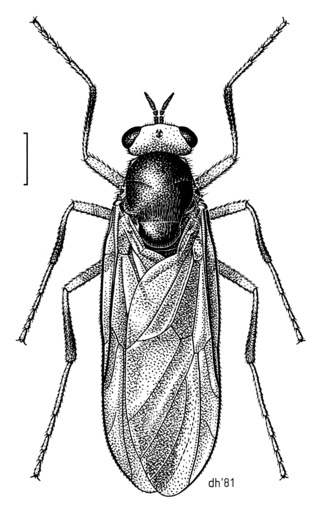
Inopus rubriceps, known generally as the sugarcane soldier fly or Australian soldier fly, is a species of soldier fly in the family Stratiomyidae. The fly acts as a host for the parasitoid wasps Neurogalesus carinatus and Neurogalesus militis. The species causes damage to pasture, as well as oat and maize crops, however the degree of damage it causes means it is not considered a major pest.
Pachygaster pulcher is a species of soldier fly in the family Stratiomyidae. The range of this species includes the Canadian province of Ontario.
Neopachygaster caucasica is a species of soldier fly in the family Stratiomyidae.
Pachygaster characta is a species of soldier fly in the family Stratiomyidae.
Pachygaster dorsalis is a species of soldier fly in the family Stratiomyidae.
Pachygaster flavimanus is a species of soldier fly in the family Stratiomyidae.
Pachygaster flavipennis is a species of soldier fly in the family Stratiomyidae.








